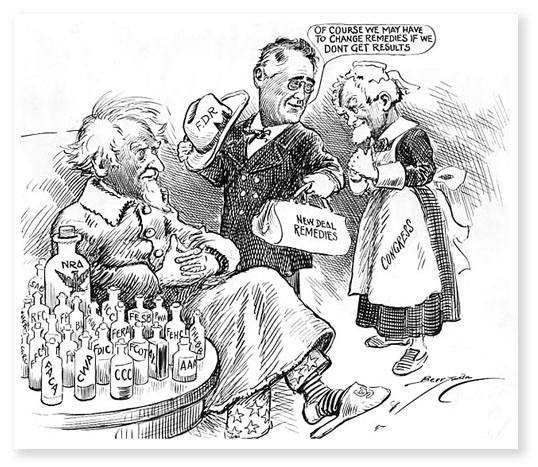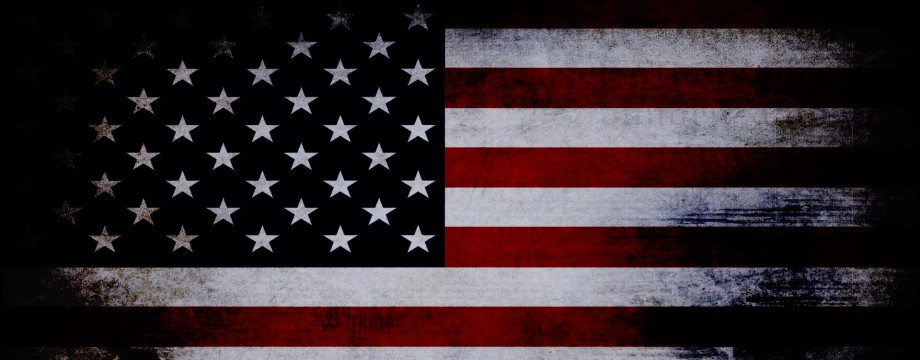
INTRODUCTION
The New Deal, introduced by President Franklin Delano Roosevelt, was intended to transform America’s economy, which had been shattered by the Great Depression. The economic downturn that followed the Wall Street Crash of 1929 had a major psychological impact as well as economic – the fact that President Roosevelt was actually doing something did a great deal to boost America’s self-esteem.
Roosevelt explained to the American people that his New Deal program would seek to deliver relief, recovery and reform — his “3 R’s.”
In Roosevelt’s first Hundred Days many acts were introduced which were to form the basis of the New Deal. The New Deal was to cover as many issues as could be imagined – be they social, economic or financial. The wave of popularity that had swept FDR into power meant that parts of the New Deal were passed without very much scrutiny. In later years many acts in the New Deal were deemed unconstitutional by the U.S. Supreme Court.
In terms of reform, the New Deal legacy may have been unmatched in American history. For better or worse, Roosevelt’s programs drastically altered the relationship between the capitalist market, the people and their government, creating for the first time in this country’s history an activist state committed to providing individual citizens with a measure of security against the unpredictable turns of the market.
Whether this vast enlargement of the government’s role in American society helped or hurt the country’s long-run prospects remains a question of great political controversy to this day, but there can be no denying the magnitude of change wrought by FDR’s presidency.
TASK
In learning about our 32nd Commander in Chief and his Presidency, you will research several and often controversial New Deal programs in order to gain a better understanding of the culture of the 1930’s and the government’s attempts to end the economic depression. You will ultimately decide whether or not these attempts brought the nation out of the Great Depression.
PROCESS
When a link is not provided, use a metasearch such as Dogpile or Unabot, or a search engine/directory such as Google or Bing. Be sure to answer each in Google Classroom, in complete sentences.
Historical Focus Category: Answer any 3 of the following questions:
1) When was FDR elected to his first political office and what was it?
2) What appointed position did he hold during Woodrow Wilson’s administration?
3) What caused him to temporarily leave politics in 1920?
4) What disease did he contract in 1921 and what effect did it have on him?
5) When did he re-enter public office and what position was he elected to?
6) How many times was he elected President and in what years?
7) What did he die of and when?
Political Focus Category Answer any 3 of the following questions:
1) How many times was FDR elected to public office?
2) How many positions were in his cabinet? How many cabinet positions are there today?
3) Why was his appointment of his Secretary of Labor significant?
4) What did he promise in his First Inaugural Address?
5) What does FDR say about one-third of the nation in his second inaugural?
6) What do these political cartoons tell us about the first 100 days of his first term?
7) What do these political cartoons tell us about FDR’s Supreme Court Packing Plan?
Economic Focus Category Answer any 2 of the following questions:
1) What is the purpose of the Social Security program?
2) How were labor unions affected by the New Deal?
3) Give the name and acronym for the following New Deal program: employment and vocational training for needy young men through work in the conservation and development of natural resources
4) Give the name and acronym for the following New Deal program: created in 1933 to regulate interstate and foreign communication by telegraph, telephone, cable, and radio to insure the deposits of approved banks against loss in the event of bank failure.
5) Give the name and acronym for the following New Deal program: created in 1934 to encourage residential construction, repair, and modernization by insuring loans and mortgages.
6) Give the name and acronym for the following New Deal program: created in 1935 to protect employees in their rights to self-organization and collective bargaining.
7) Give the name and acronym for the following New Deal program: created in 1933 to operate government-owned properties at Muscle Shoals, Ala.
8) Give the name and acronym for the following New Deal program: created in 1935 to relieve unemployment.
Geographic Focus Category Answer any 2 of the following questions:
1) What impact did the TVA have on the people and the land?
2) What was the impact of the CCC Camps in Utah?
3) What patterns of migration were caused by the drought in the plains? What was the impact of this on the land and the people?
4) What was the impact of the New Deal in Michigan?
* Due

